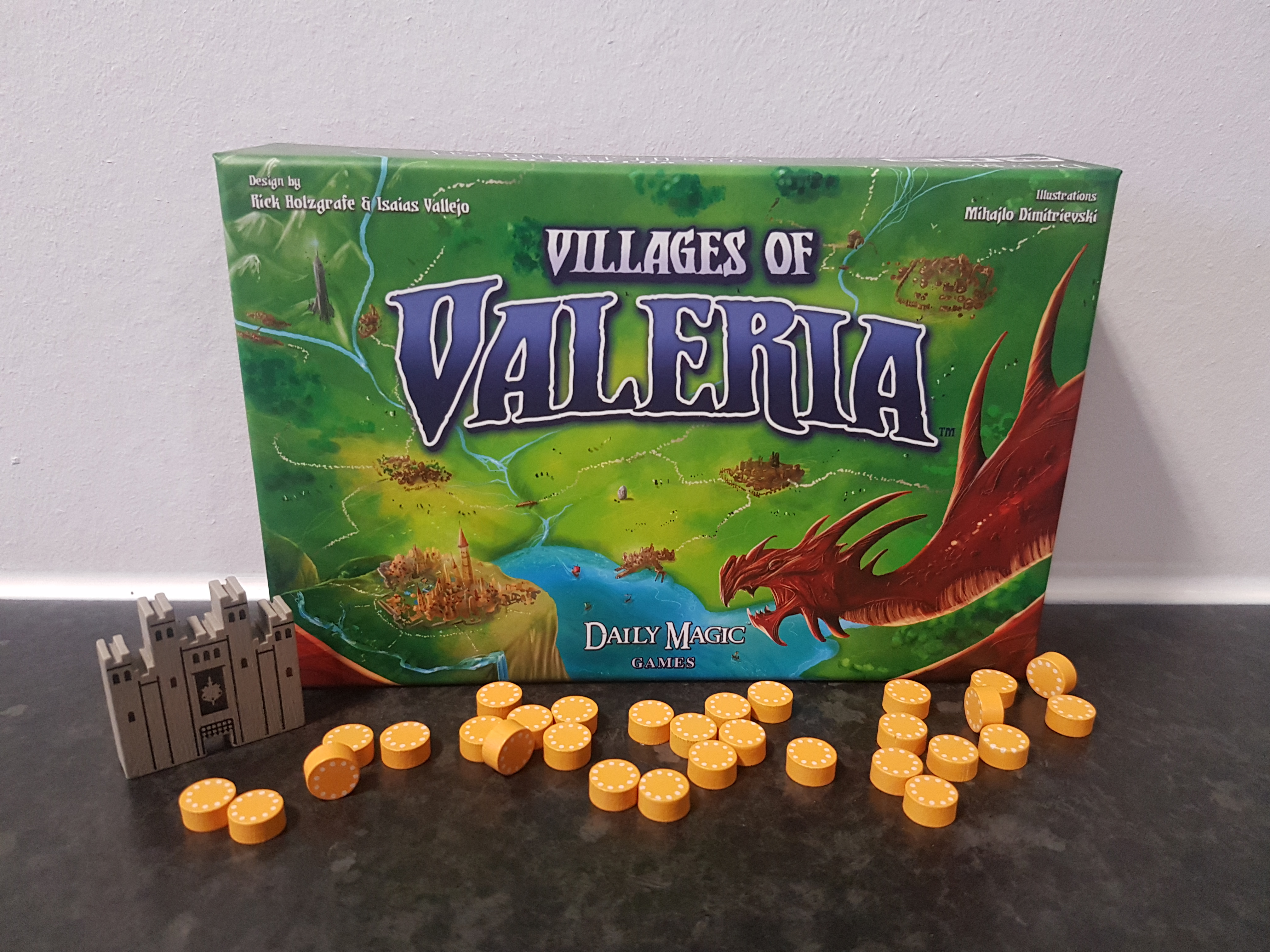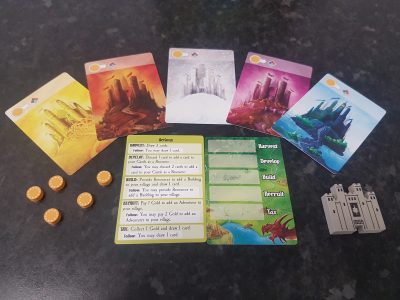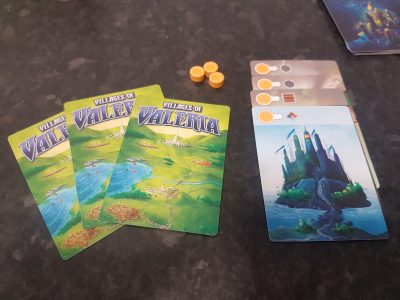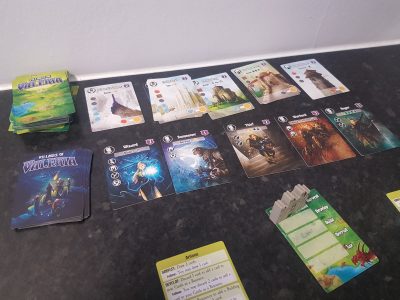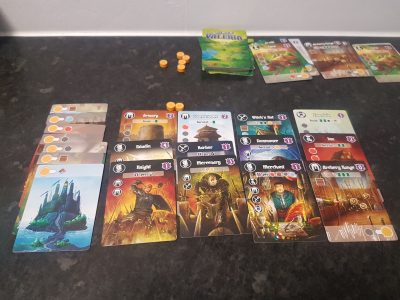Villages of Valeria is a fantasy themed card game for 1 – 5 players from publisher Daily Magic Games. The game sees players build a village full of buildings and adventurers, all in an attempt to be crowned the next capital city. Over 100 cards are included in the box split into castles, buildings, adventures and even some helpful action cheat sheets. However, does this small game try to fit too much into the box? Let’s find out!
Setup is extremely easy with only a few things to be done. Each player takes a castle card (these are only visually different), a player aid card (which has the actions and symbols), 6 building cards and 3 gold coins. Then, draw lines of 5 cards are formed for the buildings and adventurers separately. A set amount of gold, determined by the player count, is placed into play as a bank and setup is complete.
Players get to choose one of their six cards to develop into a resource at no cost and from here it is straight into the game, with the first player taking the first action. Each of the five actions comes with two stages: a main action that the active player takes and a follow action that other players can choose to do. These follow actions are balanced by being watered down versions, either being more expensive or less rewarding.
Harvest allows the active player to draw three cards from draw line or blindly from the top of the buildings deck. If taken from the draw line the cards must be taken from the top of the piles, with any empty piles being replaced by the deck. The follow action, then available to everyone else, is to draw a single card in the same way. The second available action is Develop. This sees the active player discard one card onto a draw line pile to slide one card underneath their castle as a resource. Other players can then follow this by discarding 2 cards to develop a third as a resource.
Next up is the Build action. Build sees the active player place their gold onto resource cards to be able to add a building into their village, followed by drawing a new card. Resources come in 4 main types: food, stone, wood and magic. Some buildings, such as everyone’s starting Castle, have a special Any Resource symbol that can be used to replace a single needed resource: otherwise players need the number of gold coins and the correct resources to build the building.
Those following can build via the same process but do not get the bonus card. One interesting feature of this resource building system is that at the start of your next turn you get the gold spent on your resource cards back. On top of this you can spend gold to use other players resources, though not their castle. This does have a detrimental effect as they will claim the gold on their turn not you.
Recruit is the way players will gain adventurer cards. The active player can pay one gold to claim any adventure card on show, as long as their requirements are met. Adventures need combinations of building types to be built. For example, the Rogue needs two Shadow buildings to be built before you can claim him. Other players can then pay two gold to add an adventurer to their village. With gold being how you build buildings via resources; two gold can be a big hit to take. Thankfully, there is an easy way to get gold. Tax is the final option allowing the active player to take one gold and draw one card. Everyone else can then draw a card as the follow action.
During the game players will add buildings and adventurers to their village. These have the potential to offer bonuses, either instantly or when individual actions are taken. Instant bonuses come in the form of being able to trade a card for gold, taking cards from another player or something simple like gaining a gold coin. Other cards will have on-going benefits when actions are taken: for example, when the build action is taken you could get to draw a card. Interestingly this bonus occurs whether you are the active player or not, so you have to pay attention to what others have built when taking actions. Getting a balance between cards that instantly reward you against when you take commonly used actions and when to play them is an intriguing element of Villages of Valeria and one I’ve not yet perfected.
Depending on the player count the games ends when a specific number of buildings and adventurers has been reached by a single player. This triggers the end of the game, though players can still use the follow action in an attempt to grab some points. Victory points are then totalled from the buildings and adventurers in a village, points are awarded from special scoring powers on these cards and 1 point is earnt per gold coin. Whomever has the most points wins and gets to claim they have built the new capital of Valeria.
The flow of the gold is a tad unintuitive to explain, especially for those new to the hobby. Instead of truly spending the gold on resources, it is just placed to use the resources. This is rather reminiscent of how meeples are utilized in worker placement games, as at the start of your next turn you get them back. This can see some players hesitant to use the build action early on until it clicks that it isn’t truly spending the gold to build, unlike the recruit action. This confusion ebbs away pretty fast but can still take some a few turns to get their head around.
Villages of Valeria is incredible at keeping players around the table fully engaged in the game, by effectively having zero downtime. The use of follow actions means players are constantly on the lookout for which card they would want to take if another player uses the Harvest action, or whom to recruit if they get a chance. There are times where you can build a strategy based around what actions you think you’ll be able to follow as the active player chooses them. The follow actions are so strong I have even ended games by utilizing one, giving my opponents no time to react. Even when the outcome isn’t quite that extreme players are often left hoping for the little benefits that will lead to points.
Villages of Valeria is a small box game perfect for throwing into a bag, yet packing an entertainment punch. The designers have thankfully not compromised on the cards which are the main event of the game. I was afraid that a smaller size would have been used to fit into the box, which are painfully awkward to hold and uncomfortably shuffle. Fortunately this is not the case and we have been treated to full size, good quality cards. Being a treat isn’t an exaggeration as the artwork of the cards creates a visually stunning village as it grows in front of you. Each set of named buildings has its own artwork and the 16 adventurers are all 100% unique, adding that flair to every constructed village.
The only elements that have slightly suffered at being crammed into such a small box are the rulebook and the game’s gold coin currency. The rules are concise but they could have been much clearer by including more imagery examples used, particularly of the card special powers. The iconography is all explained in text but many learn rules easier with a visual prompt, which I feel has been cut to make the rulebook smaller in size to fit into the box.
The currency is rather small and fiddly to use and doesn’t need to be as small as it is. Even if it was doubled in size the gold would comfortably fit into the section of the box designed to house it. Potentially this has been done to keep the cost of the game down, making it more accessible to a larger number of gamers. Bigger, wider coins would have made the game feel that bit better though.
Villages of Valeria enable players to create a beautiful tableau in front of themselves as the game progresses yet the mechanics do not hide behind the artwork. Each decision made effects what bonuses you may get on a following turn and what your opponents can do straight away. Players must pay attention at all times, keeping a speed and tension about what action you choose to take. When testing the game out as a 2-player game my opponent (whom lost!) likened the experience to what 7 Wonders Duel strives to be. High praise indeed, yet I don’t feel it quite reaches those heights. Nevertheless, I do believe, given the range of player count, Villages of Valeria will more commonly hit the table.
[Editor’s Note: Villages of Valeria was provided to use by Daily Magic Games for the review.]

